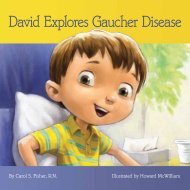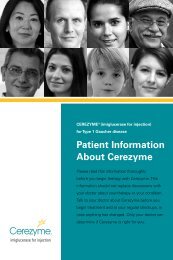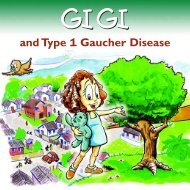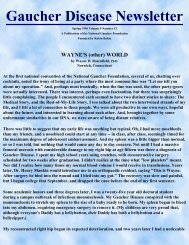Pfizer Gaucher Disease Brochure - National Gaucher Foundation
Pfizer Gaucher Disease Brochure - National Gaucher Foundation
Pfizer Gaucher Disease Brochure - National Gaucher Foundation
Create successful ePaper yourself
Turn your PDF publications into a flip-book with our unique Google optimized e-Paper software.
<strong>Gaucher</strong><br />
disease<br />
Understanding<br />
this rare disease
02<br />
03<br />
Contents<br />
05 Introduction<br />
06 What is <strong>Gaucher</strong> disease<br />
07 What are the signs and symptoms<br />
08 What are the types of <strong>Gaucher</strong> disease<br />
10 Who gets <strong>Gaucher</strong> disease<br />
POCKET<br />
11 How is <strong>Gaucher</strong> disease inherited<br />
12 How is <strong>Gaucher</strong> disease diagnosed<br />
13 How is <strong>Gaucher</strong> disease treated<br />
15 Commitment to rare disease
04 005<br />
Introduction<br />
<strong>Gaucher</strong> disease is a rare, inherited disease.<br />
It affects only about 1 in 50,000 to<br />
1 in 100,000 people worldwide.<br />
Although <strong>Gaucher</strong> disease<br />
is a rare condition, you are<br />
not alone. There are<br />
treatment options and<br />
support services available<br />
to help you manage the<br />
symptoms and minimize<br />
the impact the disease<br />
has on your life or the life<br />
of your loved ones.<br />
In addition, ongoing research<br />
continues to work toward discovering<br />
new treatment options.<br />
This brochure is provided to help answer<br />
questions about <strong>Gaucher</strong> disease.<br />
It contains basic information about<br />
<strong>Gaucher</strong> disease, including what causes<br />
it, who gets it, how it is treated, and more.<br />
This information is designed to help you<br />
have a more informed discussion with<br />
your doctor. Only he or she can help<br />
decide what is best for you.
06<br />
07<br />
What is <strong>Gaucher</strong> disease<br />
<strong>Gaucher</strong> (pronounced go-SHAY) disease is a<br />
rare, inherited disease. It is the most common<br />
condition within a family of diseases known<br />
as lysosomal storage diseases. Lysosomes<br />
are parts of our cells that produce enzymes.<br />
These enzymes are needed by our bodies to<br />
break down nutrients and waste in order for<br />
our cells and organs to work properly.<br />
Over time, <strong>Gaucher</strong> cells can collect in the<br />
liver, spleen, and bone marrow, causing the<br />
signs and symptoms of <strong>Gaucher</strong> disease. In<br />
rare cases, <strong>Gaucher</strong> cells can also collect in the<br />
central nervous system, including the brain,<br />
resulting in more severe forms of the disease.<br />
In a person with <strong>Gaucher</strong><br />
disease, cells do not produce<br />
enough of an enzyme<br />
called glucocerebrosidase<br />
(pronounced GLOO-ko-SERe-bro-sy-daze).<br />
This enzyme is needed to break down a<br />
fatty substance called glucocerebroside<br />
(pronounced GLOO-ko-SER-e-bro-side).<br />
Without enough of this essential enzyme,<br />
the fatty substance builds up in some cells,<br />
enlarging them. These enlarged cells are<br />
called <strong>Gaucher</strong> cells.<br />
How rare is <strong>Gaucher</strong> disease<br />
<strong>Gaucher</strong> disease is<br />
estimated to affect about<br />
1 in 50,000 to 1 in 100,000<br />
people worldwide.<br />
<strong>Gaucher</strong> Cells<br />
When there is not enough enzyme to break down glucocerebroside,<br />
the cells enlarge and take on a “wrinkled paper” appearance.<br />
<strong>Gaucher</strong> disease occurs more frequently<br />
in people of Ashkenazi (Eastern and Central<br />
European) Jewish descent than in those with<br />
other backgrounds. In the Ashkenazi Jewish<br />
population, it is seen in approximately<br />
1 in 400 to 1 in 600 people.<br />
What are the signs and symptoms<br />
The signs and symptoms of <strong>Gaucher</strong> disease vary from one person to another. Some people<br />
have very mild symptoms and live for years before being diagnosed with the disease. Others<br />
have very severe symptoms.<br />
Common signs<br />
and symptoms include:<br />
• Low hemoglobin count (anemia)<br />
• Low platelet count<br />
• Enlarged liver<br />
• Enlarged spleen<br />
• Bone pain<br />
• Bone disease<br />
• Fatigue<br />
• Easy bruising<br />
Less common signs<br />
and symptoms include:<br />
• Heart and lung problems<br />
• Cognitive impairment<br />
• Seizures<br />
• Dementia<br />
People with <strong>Gaucher</strong> disease can experience 1 or any combination of symptoms. Symptoms<br />
also vary depending on the type of <strong>Gaucher</strong> disease a person has.
08<br />
09<br />
What are the types<br />
of <strong>Gaucher</strong> disease<br />
There are 3 types of <strong>Gaucher</strong> disease. The type of <strong>Gaucher</strong> disease a person<br />
has depends on whether the central nervous system (spine, brain, and<br />
nerves) is involved. It also depends on the severity of that involvement.<br />
Description<br />
Symptoms<br />
Type 1<br />
• Affects organs and tissue,<br />
and is the only type that<br />
generally doesn’t involve<br />
the central nervous system,<br />
which includes the brain<br />
• Symptoms can begin to<br />
develop in early childhood<br />
or adulthood. They include:<br />
− Enlarged spleen<br />
− Enlarged liver<br />
− Low hemoglobin count<br />
(anemia)<br />
− Low platelet count<br />
Type 2<br />
• Can involve the organs and<br />
tissue, but also the central<br />
nervous system, which<br />
includes the brain<br />
• Is a rare, very severe form<br />
of the disease that affects<br />
infants<br />
• Symptoms begin in infancy<br />
and generally lead to death<br />
by 2 years of age. They<br />
include:<br />
− Enlarged spleen<br />
− Enlarged liver<br />
− Central nervous system<br />
involvement<br />
− Low hemoglobin count<br />
− Low platelet count<br />
Type 3<br />
• Can involve the organs and<br />
tissue like Types 1 and 2, but<br />
is generally more severe<br />
• Involves the central nervous<br />
system, which includes<br />
the brain<br />
• Does not progress as quickly<br />
as Type 2 and the effects of<br />
the disease on the central<br />
nervous system vary<br />
• Symptoms can begin<br />
to develop in childhood<br />
to early adulthood.<br />
They include:<br />
− Enlarged spleen<br />
− Enlarged liver<br />
− Central nervous system<br />
involvement<br />
− Low hemoglobin count<br />
− Low platelet count
10<br />
11<br />
How is <strong>Gaucher</strong> disease inherited<br />
An inheritance pattern is a way of seeing<br />
how a gene is passed down from generation<br />
to generation. This graphic shows how<br />
different combinations of people—those<br />
with and without the disease, as well as<br />
carriers—can pass <strong>Gaucher</strong> disease on to<br />
their children.<br />
The inheritance patterns show why some<br />
people have <strong>Gaucher</strong> disease, while others,<br />
who may even be closely related to the<br />
person with the disease, might not.<br />
Legend<br />
Nonaffected<br />
Carrier<br />
<strong>Gaucher</strong> disease<br />
Who gets <strong>Gaucher</strong> disease<br />
<strong>Gaucher</strong> disease is inherited, meaning<br />
it is passed down from one generation to<br />
the next through the genes of one’s parents.<br />
Genes determine various traits, like eye<br />
color, or the likelihood that one might get<br />
a certain disease.<br />
A pair of genes determines<br />
each of our traits—<br />
1 inherited from each<br />
parent. Each gene in the<br />
pair is considered either<br />
dominant or recessive.<br />
If a dominant gene is present, the dominant<br />
characteristic will develop. A recessive<br />
characteristic can only develop when 2<br />
recessive genes are present. This is referred<br />
to as an autosomal recessive inheritance.<br />
As with all of our traits, we inherit a pair of<br />
genes that is responsible for our ability to<br />
produce the enzyme glucocerebrosidase—<br />
1 gene from each parent. A person gets<br />
<strong>Gaucher</strong> disease when the mother and<br />
father each carry a recessive copy of this<br />
gene and the child receives this recessive<br />
copy from both parents. If a person inherits<br />
only 1 recessive copy of this gene, they are<br />
considered a carrier. They do not have the<br />
disease but can pass it on to their children.
12<br />
13<br />
How is <strong>Gaucher</strong> disease diagnosed<br />
How is <strong>Gaucher</strong> disease treated<br />
Diagnosing <strong>Gaucher</strong> disease can sometimes be<br />
a challenge. Some people may have symptoms<br />
for many years without knowing they have<br />
the disease. When symptoms develop, they<br />
can often be confused with other diseases.<br />
For these reasons, it can sometimes take time<br />
before a diagnosis is made.<br />
Enzyme testing<br />
A test called an enzyme assay measures<br />
glucocerebrosidase activity in the blood or<br />
urine. People with <strong>Gaucher</strong> disease will have<br />
very low levels of enzyme activity.<br />
Additional testing<br />
Some other tests are related to diagnosing<br />
or monitoring <strong>Gaucher</strong> disease:<br />
• Magnetic resonance imaging (MRI)<br />
may help show extent of disease<br />
• Computed tomography (CT) scan<br />
may show disease in the bone and soft tissue<br />
• Quantitative chemical shift imaging (QCSI)<br />
evaluates the extent of bone marrow<br />
involvement and disease severity<br />
• Dual-energy X-ray absorptiometry (DEXA)<br />
measures bone density<br />
• Bone marrow biopsy may be performed<br />
to help rule out other serious diseases<br />
Genetic testing<br />
Testing can be done to identify carriers of<br />
<strong>Gaucher</strong> disease. Genetic testing may also<br />
help identify specific gene mutations to<br />
determine which type of <strong>Gaucher</strong> disease<br />
a person has.<br />
Why early diagnosis is important<br />
<strong>Gaucher</strong> disease is a progressive disease.<br />
Left untreated, it can become debilitating<br />
and even lead to death. Some serious<br />
symptoms may become irreversible if<br />
treatment is delayed. That is why an early<br />
diagnosis is important.<br />
<strong>Gaucher</strong> disease may be suspected based<br />
on many different things, including:<br />
• Family history<br />
• Enlarged spleen<br />
• Enlarged liver<br />
• Bone abnormalities<br />
• Low hemoglobin (anemia)<br />
• Low platelet counts<br />
Although there is currently no cure for<br />
<strong>Gaucher</strong> disease, treatment can help people<br />
manage some of the symptoms of the disease.<br />
Currently, <strong>Gaucher</strong> disease is commonly<br />
treated with one of 2 types of treatment:<br />
enzyme replacement therapy (ERT) or<br />
substrate reduction therapy (SRT). These<br />
treatments work best on the symptoms of<br />
Type 1 <strong>Gaucher</strong> disease. They do not affect<br />
the brain involvement in Types 2 and 3.<br />
Enzyme replacement<br />
therapy (ERT)<br />
ERT is currently used to treat most people<br />
with Type 1 <strong>Gaucher</strong> disease. It involves<br />
giving people the enzyme that their bodies<br />
are missing by infusion, so the cells and<br />
organs can work properly. ERT works by<br />
breaking down glucocerebroside. This is<br />
the fatty substance that causes <strong>Gaucher</strong><br />
cells to enlarge, and leads to the signs and<br />
symptoms of the disease.<br />
Substrate reduction therapy (SRT)<br />
The goal of SRT is to minimize the production<br />
and accumulation of glucocerebroside within<br />
cells. SRT works by reducing the amount of<br />
glucocerebroside the cells make, so less fatty<br />
waste accumulates in the cells. SRT is taken<br />
orally. It serves as an option for people who<br />
cannot use ERT.<br />
Managing <strong>Gaucher</strong> disease<br />
<strong>Gaucher</strong> disease is a lifelong condition.<br />
As always, a doctor is the best source<br />
to discuss treatment options for<br />
<strong>Gaucher</strong> disease.
14<br />
15<br />
Commitment<br />
to rare disease<br />
As one of the world’s largest research-based pharmaceutical companies,<br />
<strong>Pfizer</strong> is committed to helping address<br />
the unmet medical needs of people with<br />
rare diseases.<br />
<strong>Pfizer</strong> partners with advocacy groups, academic organizations, and<br />
biopharmaceutical companies to discover, develop, and deliver new<br />
treatments and support programs for rare diseases.<br />
Where can I find additional support<br />
There are several organizations and associations that<br />
can provide you with additional information. They also<br />
offer a safe place to reach out for support and share<br />
with others who are living with <strong>Gaucher</strong> disease.<br />
The resources listed below are not associated with<br />
<strong>Pfizer</strong> Inc. The URL addresses are provided as a<br />
convenience to you. <strong>Pfizer</strong> accepts no responsibility<br />
for the content or services of the linked sites.<br />
<strong>National</strong> <strong>Gaucher</strong> <strong>Foundation</strong>:<br />
www.gaucherdisease.org<br />
Genetic Alliance:<br />
www.geneticalliance.org<br />
<strong>National</strong> Organization for Rare Disorders (NORD):<br />
www.rarediseases.org
Committed to the<br />
<strong>Gaucher</strong> Community<br />
NPE00511/TAL456402-04 © 2012 Pfi zer Inc. All rights reserved. Printed in USA/May 2012













